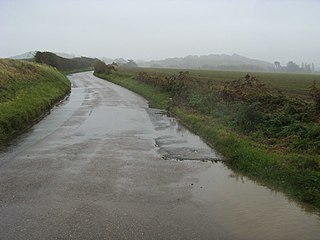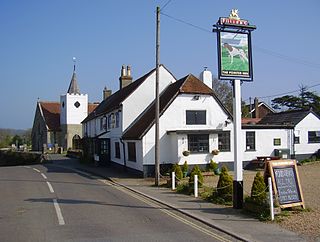
Wherwell is a village on the River Test in Hampshire, England. The name may derive from its bubbling springs resulting in the Middle Ages place name “Hwerwyl” noted in AD 955, possibly meaning “kettle springs” or “cauldron springs.” Pronunciation of the name has ranged from “Hurrell” to “Wer-rel” to present-day “Wher-well.”

St Peter's Church, Havenstreet is a parish church in the Church of England located in Havenstreet, Isle of Wight.

The Great Budbridge Manor is a manor house just south of Merstone, near Arreton, Isle of Wight, England. Fish ponds on the grounds appear medieval.

Apse Manor is a manor house on the Isle of Wight, situated just within the eastern boundary of the Newchurch parish. The house is pleasantly situated just to the north of the high road from Shanklin and as of 1912 retained a room with a stone fireplace and a heavy panelled Tudor ceiling.
Ryde Manor is a manor house in Ryde on the Isle of Wight, situated within the Newchurch parish. It was historically linked with Ashey Manor.
Branston Manor is a manor house on the Isle of Wight, situated within the Newchurch parish.
Chillingwood Manor is a manor house on the Isle of Wight, situated within the Newchurch parish.
Haven Street Manor is a manor house on the Isle of Wight, situated at Havenstreet within the Newchurch parish.
Holloway Manor was a manor house on the Isle of Wight, situated within the Newchurch parish. It lies just to the north of Ventnor. It was held of the honour of Carisbrooke Castle and formed part of the estate of John de Lisle in the Island at the end of the 13th century. It followed the descent of South Shorwell until 1641, when it is mentioned for the last time. It is probably the same as the modern Ventnor Manor, which is mentioned for the first time in 1755 and then belonged to the Pophams of South Shorwell. Nearly all the land in Ventnor was sold in 1820 by the Hill family to John Hamborough and building speculators, and the manor no longer exists. Holloway can now only be identified by the Holy Well spring on the down, from which possibly the holding derived its name. In a dispute as to boundaries in 1617, witnesses deposed that Ventnor, Littletown and Holloway were tithings of themselves and that Sir Edward Dennis' ancestors kept court and law day at Holloway, where his tenants did suit royal.
Steephill Manor is a British manor house on the Isle of Wight, situated within the Newchurch parish.
Smallbrook Manor is a manor house on the Isle of Wight, lying at the north-eastern boundary of Newchurch parish. It doubtless took its name from the stream that here forms the boundary of the parish. It is of ancient origin, as in 1280 William de Smallbrook (Smalebrook) granted land to his son Hugh. It was held at the end of the 14th century by the Wyvill family, and remained in their possession until 1491–2, when Stephen Wyvill, the last of the family, sold it to Henry Howles. Smallbrook passed in the Howles family until the reign of Elizabeth, when it was divided between co-heirs and sold to Sir William Oglander. In the court held at Ashey Manor, 1 November 1624, Sir John Oglander was returned as a freeholder and free suitor of the manor for his farm called 'Smallbroke.' The estate has since descended with Nunwell and as of 1912 was held by Mr J. H. Oglander, who had the Court Rolls in his possession.
Winston Manor is a manor house on the Isle of Wight, situated in the Newchurch parish. Judging from the Domesday Book entries, it was an important manor held in part by the king and in part by William and Gozelin,sons of Azor. The king's portion formed two manors with a virgate of land in Soflet and was valued at £3, while the Azor land was held by six tenants and was worth 70s., which makes up a considerable holding if the entries refer to the same place. It seems to have early been among the endowments of Christchurch Twyneham, being confirmed to the convent by William de Redvers, Earl of Devon. In 1241 Richard Quor gave up to the prior all his right in the manor, and the priory still held it at the end of the century as a thirteenth part of a fee. Its further history is not known, but it came in the 19th century into the hands of Mr. Alfred Smith, and as of 1912 it was owned by his daughter's trustees.
Wroxall Manor was a manor house on the Isle of Wight, situated in the Newchurch parish.
Princelet Manor, is a manor house on the Isle of Wight, situated in the Newchurch parish. It a small holding to the south-west of Apse Heath, and was held by the Lisles of Wootton. Of them it was held by the Kingstons of Kingston until the middle of the 14th century. It was held in 1428 by Richard Hearn and John Mayhew. Princelet was purchased at the end of the 16th century by Richard Gard, who in 1617 left an annuity issuing out of it to the poor of Newchurch. In 1780 John White paid a fee-farm rent for it, but in 1837 it was owned by William Thatcher; the owner as of 1912 was Mr. Charles Allen.
Wackland Manor, is a manor house on the Isle of Wight, situated in the Newchurch parish. It was held in the 13th century under the Lisles of Wootton, but in 1311–12 was said to be held of Ralph de Gorges of Knighton Gorges Manor. At the end of the 13th century it was held by John de la Brigge, from whom it passed with Bridge Court (q.v.) to the Kingstons. It followed the descent of Kingston until 1424, when Robert Dingley and Lewis Meux conveyed it to John Taillour, who was returned in 1431 as holding Wackland. Its descent has not been traced from that time until the end of the 18th century. Some time before 1786 it must have been in the possession of Thomas Davis, as he left a charge of 20s. upon it for charities. In the early part of the 19th century Wackland was the residence of a hunting farmer, well known as 'Squire' Thatcher, who kept and hunted a pack of harriers. Mr. E. Carter was lord of Wackland in 1878, and as of 1912 it belonged to the trustees of the late Mr. Thomas F. Perrott.
Hale Manor is a manor house on the Isle of Wight, situated in the parish of Arreton. It forms the south-eastern portion of the parish adjoining Newchurch, and comprises the high ground to the south of the River Yar above Horringford.
Borthwood Manor is a manor house in the parish of Brading on the Isle of Wight.





